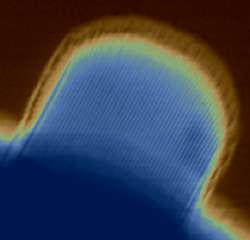| enginuity |
|
home | contents | previous | next |
Amazing arrays
Since its first discovery in 1991, the existence of a new form of carbon as nanotubes has excited scientists the world over. Carbon in the form of nanotubes has the potential to form a material of great mechanical strength (a hundred times stronger than steel)as well as displaying remarkable mechanical properties. Dependent on the arrangement of the atoms within the nanotubes, they can either be conducting, insulating or act as semi-conductors. As the tubes are so small, with diameters of the order of 1nm (ten thousand times less than a human hair) the implications for miniaturisation and speeding up of electronic components are immense.

A perfectly ordered array of nanotubes,each of diameter 1.6 nm.
The stumbling block to date has been how to fabricate the tubes in such a way as to produce the required properties. All the known methods of fabrication produced a disordered mass of tubes with correspondingly random structures and properties. This is all about to change, with a major breakthrough in April this year, made in the Department's Nanoscale Science Laboratory (NSL), headed by Professor Mark Welland, in conjunction with Professor Jim Gimzewski at UCLA and Dr. Maria Seo at IBM, Zurich.
Dr Colm Durkan, a researcher in the NSL explains: "We made our discovery quite by chance, while we were trying to fill nanotubes with metal, using a previously reported technique. We discovered that by using fullerene molecules, a form of carbon commonly known as 'Bucky Balls', as the starting point for growing nanotubes, and by adding a suitable catalyst and heating to 900°C, we can produce arrays of aligned carbon nanotubes, all with identical properties. These are single crystals of carbon in a new form and it's the first time that anyone has been able to produce this type of material. That means we now have the technology to fabricate nanotubes with the electrical and mechanical properties that we require, and we can position them where we want and at any orientation. This is also a major step towards being able to produce carbon nanotubes as a bulk material, and we can already begin to investigate many different applications for the material."
Described by other workers in the field as the most stunning result in 'buckytube' research in a year, the team's findings have left them speechless. "It was so unexpected to fabricate perfect crystalline arrays of nanotubes in this way, when all previous attempts have shown nanotubes wrapped together looking like plates of spaghetti." says Mark Welland. "We couldn't believe it at first, and it has taken six months before we were convinced that what we were seeing was real. I am still amazed at the beautiful images of these crystals."
Research will now concentrate on investigating the electrical and mechanical properties of the various crystalline forms of the new material, and will look towards developing applications.
For further information, please contact Professor Mark Welland, T:01223 332676,email: mew10@eng.cam.ac.uk.
| number 10, June 2001 | home | contents | previous | next |